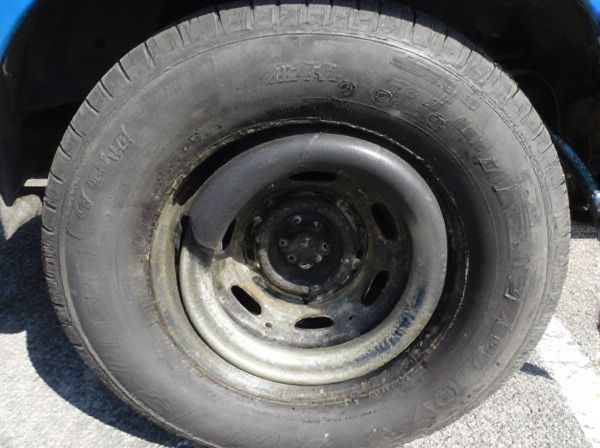
Photo illustration: Tube vs Tubeless
Tube tires use an inner tube to hold air, which can be prone to punctures and adds extra weight. Tubeless tires eliminate the inner tube, creating an airtight seal directly with the rim, offering better puncture resistance, improved traction, and a smoother ride. You can benefit from tubeless setups by experiencing fewer flats and lower rolling resistance, especially on rough terrain.
Table of Comparison
| Feature | Tube Tires | Tubeless Tires |
|---|---|---|
| Structure | Inner tube holds air inside the tire casing | Air sealed directly between tire and rim |
| Puncture Resistance | More prone to flats due to tube punctures | Better resistance; sealant can self-repair small holes |
| Weight | Heavier due to inner tube | Lighter overall |
| Rolling Resistance | Higher, caused by friction between tube and tire | Lower, improves efficiency and speed |
| Maintenance | Tube repair or replacement required on puncture | Simple patch or sealant refill; easier roadside fixes |
| Compatibility | Works with most rim types | Requires compatible tubeless-ready rims and tires |
| Cost | Generally lower initial cost | Higher upfront but cost-efficient over time |
| Performance | Standard performance | Enhanced grip and stability |
Introduction to Tube and Tubeless Tyres
Tube tyres consist of an inner tube that holds air inside a separate tire casing, providing a traditional design widely used in bicycles and motorcycles. Tubeless tyres, on the other hand, integrate the air retention system directly into the tire and rim, eliminating the need for an inner tube and enhancing puncture resistance and performance. The primary distinctions lie in their construction, air retention methods, and suitability for different terrains and usage demands.
Construction Differences: Tube vs Tubeless
Tube tires feature an inner tube that holds air separately from the tire casing, while tubeless tires create an airtight seal directly between the tire and rim. Tube tires rely on a separate inner tube made of rubber, which can be punctured or pinched, whereas tubeless tires use a specially designed rim and tire bead to maintain air pressure without an inner tube. This fundamental construction difference impacts weight, rolling resistance, and puncture repair methods.
Performance Comparison
Tubeless tires offer superior performance by reducing rolling resistance and improving traction through better air pressure regulation, making them ideal for high-speed and off-road cycling. Tube setups tend to be heavier and more prone to punctures, which negatively impacts endurance and overall ride quality. The enhanced sealant technology in tubeless tires further minimizes flat tire risks, delivering a more efficient and smoother cycling experience.
Safety Features and Concerns
Tube tires contain an inner tube that holds air, which can cause sudden air loss if punctured, increasing the risk of accidents. Tubeless tires use a sealed system that allows slower air leakage and self-sealing properties from sealant, enhancing ride safety by reducing blowouts. Emergency roadside repairs are easier and faster with tubeless setups, minimizing downtime and improving overall safety during rides.
Maintenance and Repair
Tube tires require regular pressure checks and are prone to punctures, necessitating frequent repairs or replacements of inner tubes, especially on rough terrain. Tubeless tires offer easier maintenance by self-sealing minor punctures with sealant, reducing the need for immediate repairs and lowering the risk of flats. Repairing tubeless tires often involves simply reinjecting sealant or using a plug kit, making the process faster and more convenient compared to replacing an inner tube.
Cost Analysis: Initial and Long-term
Tube tires generally have a lower initial cost compared to tubeless systems, making them more budget-friendly for entry-level cyclists. Over time, tubeless tires often prove to be more cost-effective due to fewer punctures, lower maintenance, and reduced need for replacements. While tubeless setups may require higher upfront investments in tires, valves, and sealants, the long-term savings from improved durability and performance offset these expenses.
Fuel Efficiency Impact
Tubeless tires significantly improve fuel efficiency by reducing rolling resistance compared to traditional tube tires, allowing vehicles to require less energy for movement. The absence of an inner tube reduces weight, contributing to better mileage and lower fuel consumption. Enhanced sealing in tubeless designs minimizes air loss, maintaining optimal tire pressure which is crucial for maximizing fuel economy.
Compatibility and Installation
Tube tires require a separate inner tube, making them compatible with most traditional rim designs but adding weight and puncture risk. Tubeless tires fit directly onto specially designed rims with airtight seals, reducing flat tire risk and improving ride efficiency. Installation of tubeless systems demands precision and compatible rim profiles, often needing specific sealants and valves, while tube tires offer simpler, quicker setup on a wider range of rims.
Longevity and Durability
Tubeless tires exhibit enhanced longevity and durability compared to traditional tube tires due to their ability to self-seal small punctures and reduce the risk of pinch flats. The absence of an inner tube eliminates friction between the tire and tube, resulting in less heat buildup and extended tire life. High-quality tubeless setups also provide improved impact resistance and better adaptability to rough terrain, making them a preferred choice for long-lasting performance in mountain biking and road cycling.
Choosing the Right Tyre for Your Needs
Tube tyres offer easier maintenance and are generally more affordable, making them ideal for casual riders and those prioritizing convenience. Tubeless tyres provide superior puncture resistance, lower rolling resistance, and enhanced ride comfort, suiting advanced cyclists and off-road enthusiasts. Selecting the right tyre depends on factors such as terrain, riding style, and budget, with tubeless systems favored for performance and tube tyres preferred for simplicity.
 caratoz.com
caratoz.com